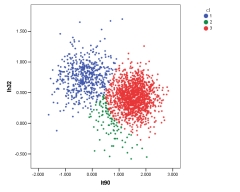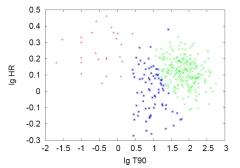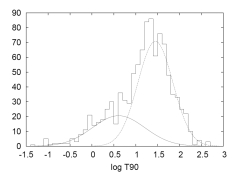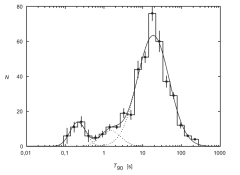|

|
BATSE groups
Gamma-ray bursts can be divided into three groups ("short", "intermediate", "long") with respect to their durations. A physically more reasonable definition of the intermediate group can be presented, using also the hardnesses of the bursts. An anticorrelation between the hardness and the duration is found for this subclass in contrast to the short and long groups.
|
|

|
Swift groups
The duration distribution analysis of the bursts observed by the Swift satellite also favors the three-component model. We extended the analysis of the Swift data with spectral information. We showed, using the spectral hardness and duration simultaneously, that the maximum likelihood method favors the three-component against the two-component model.
|
|

|
BeppoSax groups
We analyzed - using the Maximum Likelihood (ML) method - the duration distribution of the 1003 GRBs listed in the catalog with duration. In the BeppoSAX data the short bursts are underrepresented, mainly caused by the different triggering system. Our major result is the identification of the intermediate group.
|
|

|
RHESSI groups
The RHESSI data confirm that GRBs can be separated into a short and long class, and that the short GRBs are on average harder than the long ones. The two-dimensional analysis in the hardness/duration plane as well as the maximum likelihood fit of the duration distribution show a third class with intermediate duration and similar hardness as the short class.
|
|
|
More ...
|


